Anti Inflammatory Tea Market Research, 2032
The global anti inflammatory tea industry was valued at $2.1 billion in 2022, and is projected to reach $3.6 billion by 2032, growing at a CAGR of 5.5% from 2023 to 2032. The demand for anti-inflammatory tea is primarily driven by an increase in consumer awareness regarding the health benefits of anti inflammatory tea beverages, including reduced inflammation, pain relief, and immune system support. Moreover, growing interest in natural remedies, rising prevalence of inflammatory conditions, and a shift toward healthier lifestyles contribute to the expansion of the market.
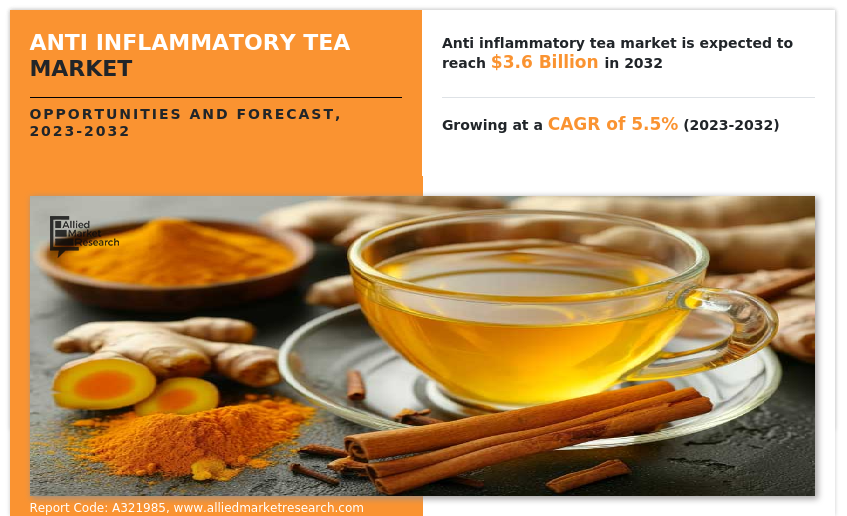
Anti-inflammatory tea is an herbal beverage crafted to reduce inflammation in the body, promoting overall health and well-being. It comprises ingredients rich in anti-inflammatory properties, such as ginger, turmeric, cinnamon, and green tea. Blending these ingredients creates a flavorful and therapeutic tea that can be enjoyed daily as a natural remedy for various inflammatory conditions, including arthritis, digestive issues, and general inflammation-related discomfort, which thus contributes to a healthier lifestyle.
Key Takeaways of Inflammatory Tea Market Report
- By type, the black tea segment was the highest revenue contributor to the market in 2022.
- As per packaging, the tea bags segment was the largest segment in the global anti-inflammatory tea market during the forecast period.
- By distribution channel, the supermarket-hypermarket segment was the largest segment in 2022 owing to the presence of extensive product variety and various promotional efforts to increase the product awareness among health conscious consumers.
- Region-wise, Asia-Pacific was the highest revenue contributor in 2022 owing to the cultural reliance on herbal remedies, rising health consciousness, and a growing aging population prone to inflammatory conditions.
Market Dynamics
Rise in awareness regarding health benefits of anti inflammatory tea
Growth in consumer awareness about natural remedies for inflammation is a significant driver that has boosted the demand for the anti inflammatory tea industry. As individuals become more health-conscious and seek alternatives to traditional pharmaceuticals, they are preferring herbal solutions for managing inflammation. This increased awareness derives from research highlighting the efficacy of certain herbs and botanicals in reducing inflammation coupled with a desire for holistic approaches to wellness.
Moreover, the accessibility of information through the internet and social media platforms has played a crucial role in educating consumers about the benefits of anti-inflammatory teas. As people become more informed about the potential side effects of long-term use of pharmaceuticals and the benefits of natural remedies, they are actively seeking products such as anti-inflammatory teas. These teas offer a gentle yet effective way to address inflammation, often without the adverse effects associated with some medications. Consequently, this increased awareness has led to a rise in demand for anti-inflammatory teas as consumers prioritize preventive health measures and seek natural solutions to improve their well-being.
Higher prices of anti inflammatory tea to restrain the market growth
However, the price sensitivity among certain consumer demographics poses a significant restraint on the market demand for anti-inflammatory tea. While there is a growing interest in natural remedies and functional beverages, some consumers may get discouraged by the higher price points associated with premium herbal products. This is particularly true for price-conscious demographics or those with limited disposable income who may prioritize affordability over perceived health benefits.
Furthermore, the availability of cheaper alternatives, such as generic teas or conventional pain relievers, further increases the challenge of price sensitivity, impacting anti inflammatory tea market growth. Consumers may opt for these more affordable options, especially if they perceive them to be sufficient for their needs. As a result, anti-inflammatory tea brands must carefully balance pricing strategies to remain competitive while still ensuring profitability. Failure to address price sensitivity leads to reduced market penetration and hampers the potential for growth in segments where affordability is a primary concern.
Expansion of online retail channels
In addition, the expansion into online sales channels presents a significant opportunity in the market for the anti inflammatory tea market share by allowing brands to reach a broader consumer base. Online platforms provide a convenient and accessible avenue for consumers to discover and purchase anti-inflammatory teas from the comfort of their homes, expanding the market beyond traditional brick-and-mortar stores. With the global reach of e-commerce platforms, anti-inflammatory tea brands can enter into new markets and demographics, including consumers in remote or underserved areas who may not have access to specialized health food stores.
Moreover, online sales channels offer anti inflammatory tea market size greater flexibility in marketing strategies, enabling targeted advertising campaigns and personalized promotions to engage with specific consumer segments. By leveraging digital marketing tools and analytics, brands can optimize their online presence, enhance brand visibility, and drive customer engagement. This digital expansion not only enhances accessibility for consumers but also fosters brand loyalty and strengthens market competitiveness in an increasingly digitalized marketplace.
Segmental Overview
The anti-inflammatory tea market is analyzed on the basis of type, packaging, distribution channel, and region.
By Type
By type, the black tea segment dominated the global anti inflammatory tea market demand in 2022 and is anticipated to maintain its dominance during the forecast period owing to its widespread availability, familiarity, and high flavor profile, which appeals to a broad consumer base. In addition, black tea contains flavonoids and other bioactive compounds that possess anti-inflammatory properties, making it a popular choice for individuals seeking natural remedies. Its versatility allows for easy incorporation into various blends and formulations, further solidifying its position as the leading segment in the anti-inflammatory tea market.
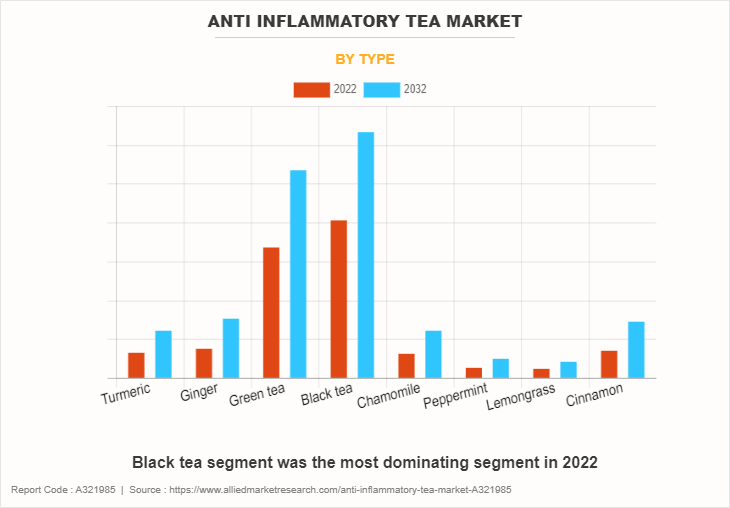
By Packaging
By packaging, the tea bags segment dominated the global anti inflammatory tea market in 2022 and is anticipated to maintain its dominance during the forecast period. Tea bags provide a convenient solution for consumers to enjoy anti-inflammatory teas without the need for additional brewing equipment or preparation time. Moreover, the individual packaging of tea bags ensures freshness and preserves the quality of the herbal ingredients, maximizing their anti-inflammatory benefits. This packaging format also offers precise portion control, making it appealing to consumers seeking standardized doses of herbal remedies. As a result, the tea bags segment has emerged as the preferred choice for consumers looking for convenient and effective ways to incorporate anti-inflammatory teas into their daily routines.
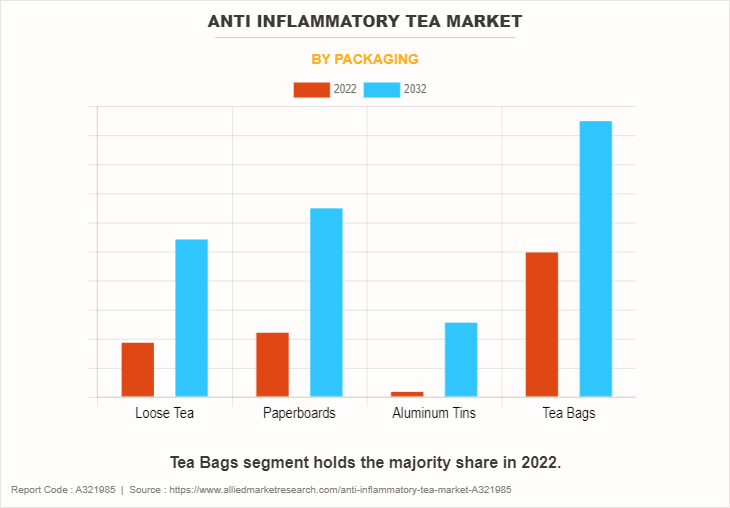
By Distribution Channel
By distribution channel, the supermarket-hypermarket segment dominated the global anti-inflammatory tea market in 2022 and is anticipated to maintain its dominance during the forecast period. Supermarkets-hypermarkets serve as key retail destinations for consumers, offering a comprehensive selection of anti-inflammatory teas alongside other groceries and wellness products. Their extensive distribution networks and large-scale operations make it convenient for consumers to purchase anti-inflammatory teas during their routine shopping trips. Additionally, supermarkets-hypermarkets often feature promotional displays and in-store advertising, increasing visibility and driving sales of anti-inflammatory teas. As a result, these retail channels have emerged as primary drivers of market growth, capturing a significant share of consumer spending on anti-inflammatory tea products.
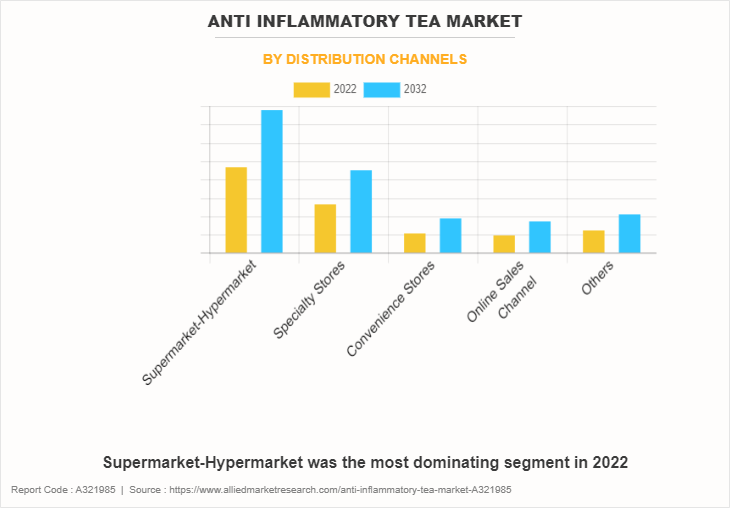
By Region
Region-wise, Asia-Pacific is anticipated to dominate the market with the largest share during the forecast period. The region's large population, rise in health consciousness, and increase in disposable income contribute to robust demand for natural remedies such as anti-inflammatory teas. Moreover, Asia-Pacific's diverse climate and agricultural resources facilitate the cultivation of key ingredients like turmeric and ginger, further strengthening its position as a major producer and consumer of anti-inflammatory teas. These factors collectively drive the region's anticipated dominance in the global anti-inflammatory tea market during the forecast period.
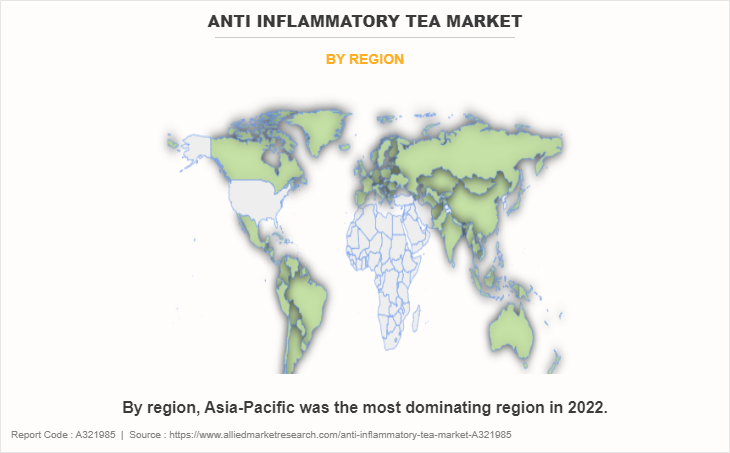
Competitive Analysis
The key players include The Hain Celestial Group, Tata Consumer Products, Dilmah Ceylon Tea Company, Bigelow Tea Company, Mountain Rose Herbs, Terra Teas Organic, Full Leaf Tea Co., Davidson's Organics, ArtfulTea, and Yogi.
Several well-known and up-and-coming brands are competing for market dominance in the expanding anti inflammatory tea market forecast. Smaller, niche firms have become more well-known for catering to consumer demands and tastes. Large conglomerates, however, still control the majority of the market and frequently buy creative start-ups to broaden their product lines.
Private label brands created by merchants and e-commerce platforms are another aspect of the competitive market. While they provide more affordable options, they might have different recognition or range of products than well-known companies. An important competition component is innovation in formulations, ingredient sourcing, and sustainability policies. Companies that can influence the preferences of their considered audience and coordinate with their ethical and environmental principles hold a competitive edge against competitors.
Recent Developments in Anti Inflammatory Tea Market
- In June 2023, Bigelow Tea launched three new tea flavors namely, peak energy black tea plus extra L-theanine & caffeine, whispering wildflowers herbal tea plus L-theanine, and ginger honey herbal tea plus zinc in order to expand its portfolio.
- In July 2021, Tata Consumer Products Limited opened its new tea-packaging plant in Gopalpur Industrial Park of Tata Steel Special Economic Zone in order to expand its business and provide high flexibility to the operations network.
- In July 2021, Tata Consumer Products Limited launched its redesigned corporate website in order to expand its brand portfolio and enables easy access to information on products.
Key Benefits for Stakeholders
- This report provides a quantitative analysis of the market segments, current trends, estimations, and dynamics of the anti inflammatory tea market analysis from 2022 to 2032 to identify the prevailing anti inflammatory tea market opportunities.
- The market research is offered along with information related to key drivers, restraints, and opportunities.
- Porter's five forces analysis highlights the potency of buyers and suppliers to enable stakeholders make profit-oriented business decisions and strengthen their supplier-buyer network.
- In-depth analysis of the anti inflammatory tea market segmentation assists to determine the prevailing market opportunities.
- Major countries in each region are mapped according to their revenue contribution to the global market.
- Market player positioning facilitates benchmarking and provides a clear understanding of the present position of the market players.
- The report includes the analysis of the regional as well as global anti inflammatory tea market trends, key players, market segments, application areas, and market growth strategies.
Anti Inflammatory Tea Market Report Highlights
| Aspects | Details |
| Forecast period | 2022 - 2032 |
| Report Pages | 300 |
| By Type |
|
| By Packaging |
|
| By Distribution Channels |
|
| By Region |
|
| Key Market Players | The Hain Celestial Group, Inc., Dilmah Ceylon Tea Company PLC, Yogi, Mountain Rose Herbs, ArtfulTea, Full Leaf Tea Co., Bigelow Tea Company, Davidson's Organics, Tata Consumer Products Limited, Terra Teas Organic |
Analyst Review
The perspectives of the leading CXOs in the anti-inflammatory tea market are presented in this section. Consumers are choosing anti-inflammatory tea for its natural remedy properties, aiming to reduce inflammation and promote overall well-being. With ingredients such as ginger, turmeric, cinnamon, and green tea, it offers a blend rich in antioxidants and anti-inflammatory compounds. This beverage provides a flavorful and therapeutic option to help manage inflammation-related discomforts such as arthritis and digestive issues, contributing to a healthier lifestyle.
Moreover, the shift toward preventive healthcare and wellness-focused lifestyles reflects a growing awareness and prioritization of proactive measures to maintain health and prevent diseases. Instead of merely addressing symptoms reactively, individuals are embracing holistic approaches that encompass physical, mental, and emotional well-being. This shift involves adopting healthier habits, such as regular exercise, balanced nutrition, stress management, and adequate sleep. Moreover, it emphasizes preventive screenings, vaccinations, and lifestyle modifications to mitigate the risk of chronic conditions. Overall, this pattern encourages individuals to take charge of their health and invest in practices that promote long-term wellness and quality of life.
Furthermore, the development of convenient, ready-to-drink formats for on-the-go consumption caters to busy lifestyles by offering portable options that require minimal preparation. These products provide quick and easy access to beverages, allowing consumers to enjoy them anytime, anywhere, without the need for additional equipment or time-consuming brewing processes.
The global anti inflammatory tea market size was valued at USD 2.1 billion in 2022, and is projected to reach USD 3.6 billion by 2032.
The global anti inflammatory tea market is projected to grow at a compound annual growth rate of 5.5% from 2023-2032 to reach USD 3.6 billion by 2032.
The key players profiled in the reports includes The Hain Celestial Group, Inc., Full Leaf Tea Co., Davidson's Organics, Bigelow Tea Company, ArtfulTea, Tata Consumer Products Limited, Dilmah Ceylon Tea Company PLC, Mountain Rose Herbs, Yogi, Terra Teas Organic.
Asia-Pacific dominated and is projected to maintain its leading position throughout the forecast period.
Rise in awareness regarding health benefits of anti inflammatory tea, Expansion of online retail channels majorly contribute toward the growth of the market.
Loading Table Of Content...
Loading Research Methodology...



